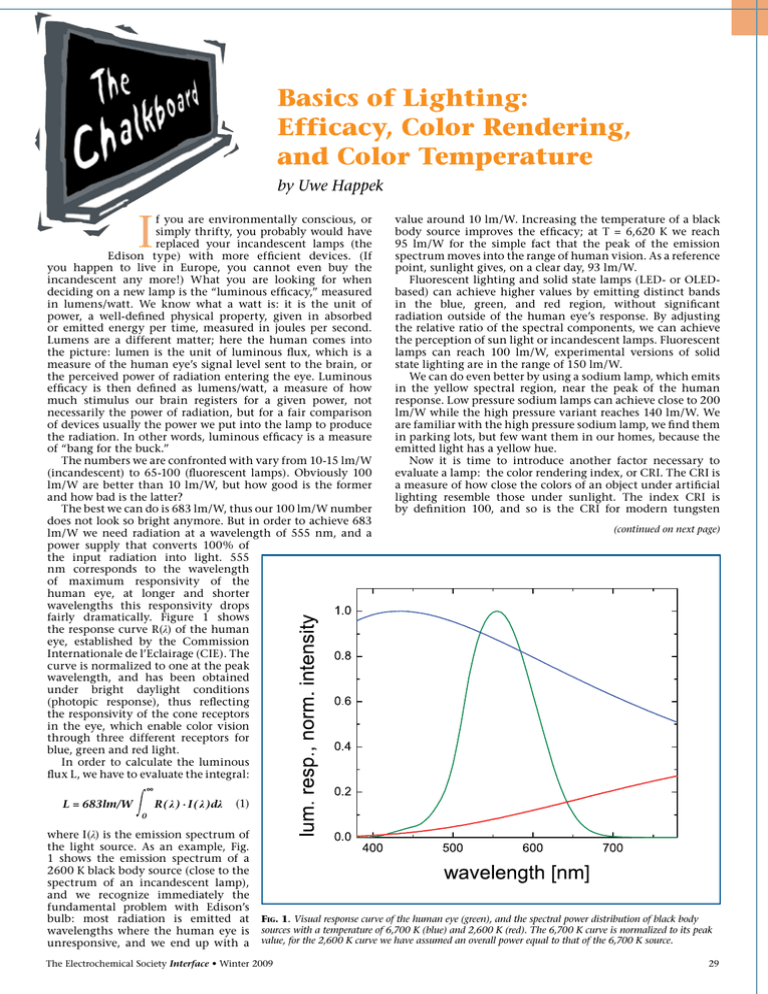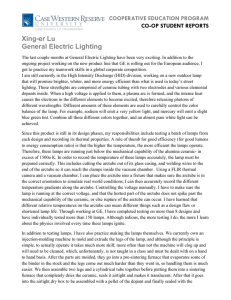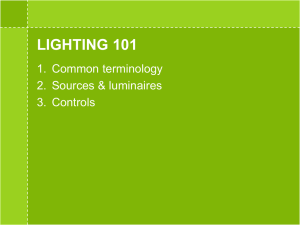Efficacy, Color Rendering, and Color
advertisement

Basics of Lighting: Efficacy, Color Rendering, and Color Temperature by Uwe Happek I f you are environmentally conscious, or simply thrifty, you probably would have replaced your incandescent lamps (the Edison type) with more efficient devices. (If you happen to live in Europe, you cannot even buy the incandescent any more!) What you are looking for when deciding on a new lamp is the “luminous efficacy,” measured in lumens/watt. We know what a watt is: it is the unit of power, a well-defined physical property, given in absorbed or emitted energy per time, measured in joules per second. Lumens are a different matter; here the human comes into the picture: lumen is the unit of luminous flux, which is a measure of the human eye’s signal level sent to the brain, or the perceived power of radiation entering the eye. Luminous efficacy is then defined as lumens/watt, a measure of how much stimulus our brain registers for a given power, not necessarily the power of radiation, but for a fair comparison of devices usually the power we put into the lamp to produce the radiation. In other words, luminous efficacy is a measure of “bang for the buck.” The numbers we are confronted with vary from 10-15 lm/W (incandescent) to 65-100 (fluorescent lamps). Obviously 100 lm/W are better than 10 lm/W, but how good is the former and how bad is the latter? The best we can do is 683 lm/W, thus our 100 lm/W number does not look so bright anymore. But in order to achieve 683 lm/W we need radiation at a wavelength of 555 nm, and a power supply that converts 100% of the input radiation into light. 555 nm corresponds to the wavelength of maximum responsivity of the human eye, at longer and shorter wavelengths this responsivity drops fairly dramatically. Figure 1 shows the response curve R(λ) of the human eye, established by the Commission Internationale de l’Eclairage (CIE). The curve is normalized to one at the peak wavelength, and has been obtained under bright daylight conditions (photopic response), thus reflecting the responsivity of the cone receptors in the eye, which enable color vision through three different receptors for blue, green and red light. In order to calculate the luminous flux L, we have to evaluate the integral: value around 10 lm/W. Increasing the temperature of a black body source improves the efficacy; at T = 6,620 K we reach 95 lm/W for the simple fact that the peak of the emission spectrum moves into the range of human vision. As a reference point, sunlight gives, on a clear day, 93 lm/W. Fluorescent lighting and solid state lamps (LED- or OLEDbased) can achieve higher values by emitting distinct bands in the blue, green, and red region, without significant radiation outside of the human eye’s response. By adjusting the relative ratio of the spectral components, we can achieve the perception of sun light or incandescent lamps. Fluorescent lamps can reach 100 lm/W, experimental versions of solid state lighting are in the range of 150 lm/W. We can do even better by using a sodium lamp, which emits in the yellow spectral region, near the peak of the human response. Low pressure sodium lamps can achieve close to 200 lm/W while the high pressure variant reaches 140 lm/W. We are familiar with the high pressure sodium lamp, we find them in parking lots, but few want them in our homes, because the emitted light has a yellow hue. Now it is time to introduce another factor necessary to evaluate a lamp: the color rendering index, or CRI. The CRI is a measure of how close the colors of an object under artificial lighting resemble those under sunlight. The index CRI is by definition 100, and so is the CRI for modern tungsten (continued on next page) ∞ R( λ ) · I( λ )dλ L = 683lm/W (1) 0 where I(λ) is the emission spectrum of the light source. As an example, Fig. 1 shows the emission spectrum of a 2600 K black body source (close to the spectrum of an incandescent lamp), and we recognize immediately the fundamental problem with Edison’s bulb: most radiation is emitted at wavelengths where the human eye is unresponsive, and we end up with a Fig. 1. Visual response curve of the human eye (green), and the spectral power distribution of black body sources with a temperature of 6,700 K (blue) and 2,600 K (red). The 6,700 K curve is normalized to its peak value, for the 2,600 K curve we have assumed an overall power equal to that of the 6,700 K source. The Electrochemical Society Interface • Winter 2009 29 (continued from previous page) incandescent lamps. The CRI for high pressure sodium lamps is about 40, and for the low pressure sodium lamp it is 0. High quality fluorescent lamps achieve a CRI of 90, which is considered excellent, and a similar value has been reported for solid-state lighting. A high CRI index often comes at the expense of efficacy, and we are in the midst of a race to find new luminescent materials that can produce a desired spectrum without sacrificing efficacy. At this point we tend to summarize the situation as follows: “High CRI, high efficacy, cheap – pick any two!” What about the parameter of color temperature? Roughly, the color temperature (CT) is the temperature of a black body whose spectrum most closely resembles that of a given light source. Incandescent lamps have a CT in the range 2600K-3000K, warm fluorescent lighting has a CT of 3000K, and cool white has a CT of 4,200K. What we prefer depends on our personal taste and is very subjective—in North America and Europe, the preference is for “warm” lighting, i.e., low CTs, while in Asia “cool” light corresponding to higher CTs is offered. What lighting we use and prefer depends on the situation: while in the office and at home, a CT in the 3000K-4000K range is preferred, the owner of a bar might opt for a CT value below 2000K. And for special occasions we might even sacrifice the luminous efficacy: the candle for your romantic dinner delivers only about 0.1 lm/W and that is quite fine. About the Author Uwe Happek is Professor of Physics in the Department of Physics and Astronomy at The University of Georgia. Prior to his move to Georgia, he spent five years in the Laboratory of Atomic and Solid State Physics at Cornell University as a postdoc/research scientist. He is a recipient of the Feodor Lynen Fellowship (Alexander von Humboldt Society), the Erskine Fellowship (University of Canterbury, NZ), and the UGA Creative Research Medal. In the L&DM Division he has served as Ttreasurer, Vice-Chair, and most recently as the Division Chair. His research interests cover many aspects of condensed matter physics, and his preferred experimental technique is optical spectroscopy, from mm-waves to the ultraviolet. He may be reached at uhappek@hal.physast.uga.edu. General Topics Please Note the Earlier Abstract Deadline: November 16, 2009 217th ECS Meeting vaNcouveR = Batteries, Fuel Cells, and Energy Conversion = Biomedical Applications and Organic Electrochemistry = Corrosion, Passivation, and Anodic Films = Dielectric and Semiconductor Materials, Devices, and Processing = Electrochemical / Chemical Deposition and Etching = Electrochemical Synthesis and Engineering = Fullerenes, Nanotubes, and Carbon Nanostructures = Physical and Analytical Electrochemistry = Sensors and Displays: Principles, Materials, and Processing Home of the 2010 Olympic Winter Games April 25-30, 2010 30 The Electrochemical Society Interface • Winter 2009




